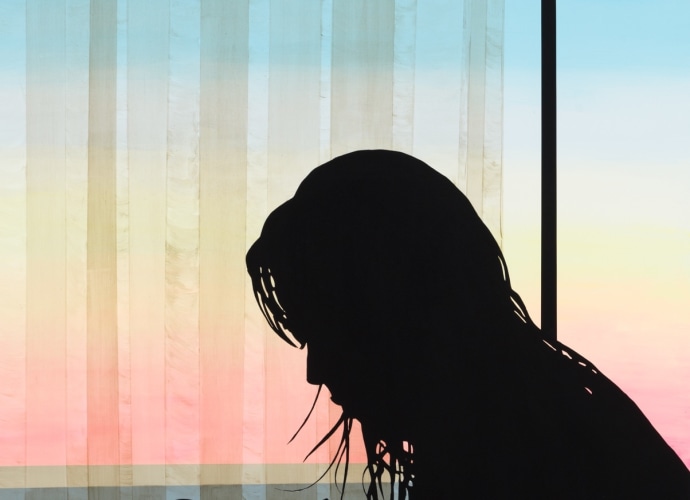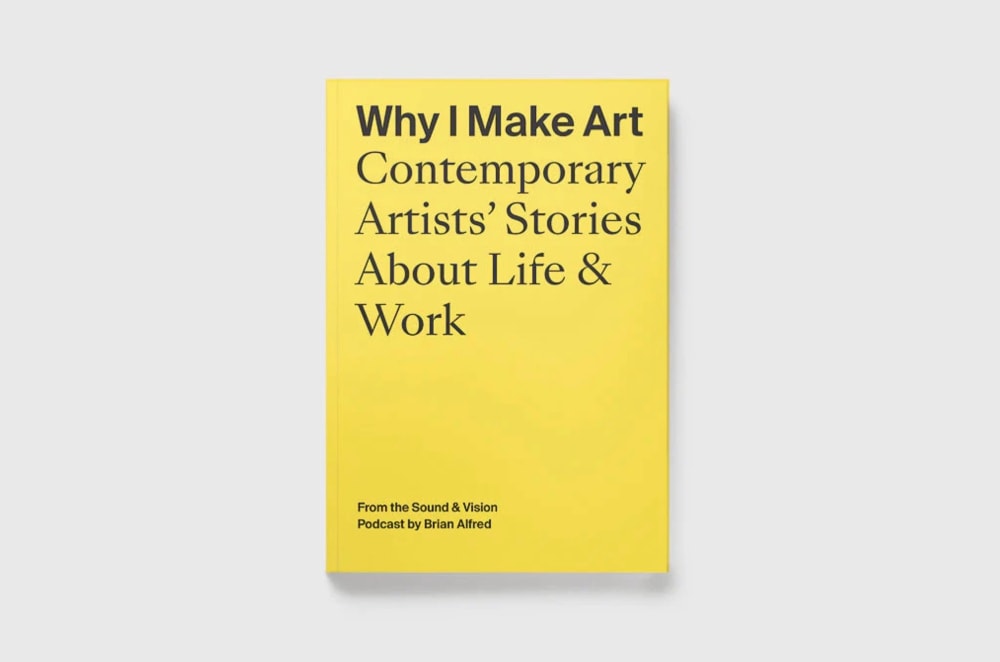
Brian Alfred | I Heard It In A Magazine
Brian Alfred of "Sound + Vision"
31 May 2022

Courtesy of Atelier Éditions.
MV: Has there been an artist that you were particularly excited to sit down with and talk to? Is there somebody who you haven't spoken to who you have on your Sound+Vision bucket list?
BA: I really want to talk to Alex Katz. I really wanted to talk to an old friend of mine, Thomas Nozkowski, but he passed away. He was one that I would have loved to speak to. Eric Fischl was a memorable one because he's been around so long. I like talking to artists who've been around - they're never at a loss for words.
The ratio of the length of the [podcast] conversation is almost a direct relationship to the age. So, if you've had someone 23, it's probably going to be around 40 minutes. Talk to someone who's like 70, you're looking at two hours at least.
MV: What are your hopes for the future of the podcast?
BA: I love doing it every week, so the moment it becomes like a job [I’m not interested]. I do it for fun, I'm not on a payroll.
I have a book coming out. I was like six months into creating the podcast and the director of the art school where I teach was like, “Hey, you should do a book on the podcast, because not everyone listens to podcast[s].” And I just thought, okay, whatever. I didn't think about it. But then over time, thinking about it, it kind of made sense. After you've done hundreds [of podcasts], there's all these good little nuggets of information. [I thought] it would be really cool for like art students to have this little book that has all this inspiration. I like the idea of it existing in a different medium.
Find Brian's Why I Make Art here.

Brian Alfred, The Field Code, 2021, Acrylic on canvas, 70 x 80 inches,
177.8 x 203.2 cm
Contributor Maria Vogel interviews artist Brian Alfred on his many hats: painter, podcaster, and sound person, to name a few.
Brian Alfred may be best known for his adept painting practice, which has been the subject of notable gallery shows around the world and collected by many of the country’s leading institutions. Despite this distinction, “artist” is just one of many hats sported by Alfred. In addition to teaching and a studio practice that extends beyond painting, Alfred is the host of renowned podcast Sound+Vision.
His leap into the world of audio was a familiar one, having been musical for most of his life and often collaborating with musicians in work and play. Though Sound+Vision began purely as a hobby driven by Alfred’s own interest in learning more about the stories of artists and musicians, it now leads the arena of visual art podcasts and boasts more than 300 episodes with globally recognized names like Diana Al-Hadid, Eric Fischl, Loie Hollowell, Rafael Lozano-Hemmer, and Leo Villareal.
This month, Alfred will debut his book, Why I Make Art, with excerpts of Sound+Vision interviews that have been conducted since the podcast’s beginning in 2016. Here, we talk to Alfred about his relationship to audio, how visual art translates into an auditory experience, and filling a niche in the podcast world.
MV: What does your visual art practice encompass? Is there a throughline that follows your work?
BA: My work involves painting, collage, digital drawing, and animation. My work has been pretty constant over the past 20 years, in my interest in the world around us, different demotic ideas and anchors through different bodies of work, but basically being interested in showing our world and what that says about us as people, by looking around us. Not dissimilar to, you know, the way Japanese prints were very much about, you know, the current way of life. It's been a big inspiration to me. But yeah, my work is just about our world, basically.
MV: Given that you have had such a robust career as an artist, what was your impetus for creating Sound+Vision and entering the podcast world?
BA: When I started teaching at Penn State - on Tuesday mornings, I would drive there and it's a four-hour drive and then Thursday night, I would drive home. So, I had these long drives, and I started listening to podcasts. I like longer ones, because it's a long trip. I liked ones with like actors and musicians just talking about their life in a more conversational tone. I was interested in finding ones like that, with artists, and that just didn't really seem to exist.
It took me like a year and a half to do some research and development and figure out the process and stuff. It was [in] 2016 that I started it. But yeah, it was to fill that. I mean, I just started it for fun, I didn't know what it was going to be, I didn't have any expectations. It became a huge part of my life and a really fulfilling part of it. Once a week, I just get to talk to people that I've oftentimes never spoke with before and get to learn about their that work.
MV: I find that when I visit with artists, I always pick up something from the conversation that impacts my work. I'm sure you feel similarly, you know, you walk away from these conversations and there's, there's such a richness that, you know, even if you're doing it “for fun”, so to speak, it ends up benefiting your own practice in ways that you can't really predict, which is cool. And I agree with you there. The art podcast landscape is pretty dull.
BA: There's not much. I think it's the only reason I really did it is because I felt like there was a niche. I didn’t think it would be something I was incredibly good at. I just thought, “Oh, well, I'll just talk to you.” I have a lot of friends who were artists and I have a history of playing music and recording it and stuff. So, I felt confident in that realm. But I never thought of myself as an interviewer. I think now, having done hundreds of them, I'm probably a lot better at it than I was at the beginning, but had no idea it would be so rewarding.
MV: I remember when I first stumbled upon the podcast and connecting the dots that it was an artist doing the podcast - for some reason, I think we expect people to be in certain lanes. So when you hear about an artist, also being kind of a journalist in this way, I think it's surprising. And maybe that also gives you a sort of edge in how you're approaching interviews from a different lens than someone like me would.
BA: I think that's definitely true. I think, especially considering my podcast is more conversational, it's less of a quote-unquote, interview of asking questions and I have an advantage, because I do this stuff. If there's one thing I'm good at with the podcast, it's disarming the people that I'm talking to. I've learned how to make them feel comfortable really quickly, like “I do what you do, I know your world”, and then I listen to them, because I'm really interested in them. And I think they get that pretty quickly, which hopefully makes for them opening up which makes for a better listener experience, you know?
MV: Why do you think artists stories translate well with this method of storytelling?
BA: I feel like when it comes to artists, when people interview artists or talk to artists, it's usually the same. Like it's the same way. It's the same handful of questions about the work. Or it's a very quick, sort of like, Oh, where'd you grow up? Or where'd you go to art school? But there's never like a real digging into an artist. I mean, can you think of anywhere where artists have been interviewed, and it goes really deep into, like, their upbringing, and like, how they became creative and what they do?
In the midst of a long conversation, what ends up happening is some of those innocuous sort of daily life questions end up blooming into a discussion about something deeper in their life. It almost always happens to where something else comes out that is really informative. So it's the genesis of these little questions of like, “Oh, what do you listen in the studio?”, and then 20 minutes later, they're talking about when they were growing up, and their dad was singing old blues songs to them. The longer form [of the podcast interview] enables those like little seeds to germinate and bloom during the conversation into a dirt roads that you normally would never go down. Like, there's been so many times where I talked to an artist and in the midst of the conversation, they'll say, like, “Oh, you know, what's crazy? I never really thought of this.” It’s cool to be able to do that, to open a door in someone's brain.
MV: I think certain types of interview styles can be a little intimidating and when it's just audio and your face isn't presented and it probably [makes guests] open up. It probably helps artists to let their guard down a little bit.
BA: Artists will always lean on the visual. We're visual people. So, if you completely take that away, then it's like, “Oh, I get a chance to talk here where I don't have to lean on the art.” It's funny, every once in a while, people be like, “You didn't talk about the artwork that much.” And it's like, well, yeah, but when you talk about someone's life, you're opening up the keys as to why they make their work and what their work is about, in a way.
MV: Why do you include musicians as a subject of focus [on the podcast]?
BA: For me, [artists and musicians] have always been intertwined. So, it just made sense, to open up the conversations to something bigger than just talking about art. Whether it's talking to an artist about music they like, or talking to a musician about, you know, their cover art. In my own work, I collaborate with musicians on my animations. And sound is a big part of what I do, it's always been part of my life. I think it brings a lightness to the conversations and music is so universal.
I'm infatuated with music. I don't know if it's some sort of like synesthesia style thing but when I look at artwork, I think of music that it sounds like. When I critique as I teach, I'm always bringing up music as a parallel to think about ideas in artwork, that are similar in music. I think it's always useful to use that as a parallel.
MV: Can you talk about one particularly memorable podcast experience?
BA: I did one with James Siena, who, I've known for a long time. We did it in his show at Pace Gallery during operating hours. So people were just walking around us and looking at us as if we were an art piece.